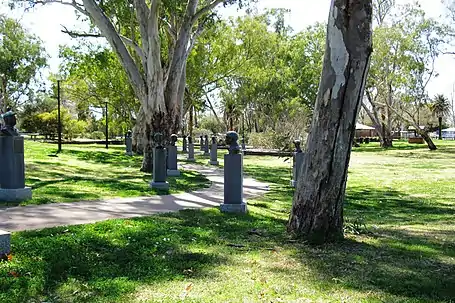Cootamundra
Cootamundra is a town in the South West Slopes region of New South Wales, Australia and within the Riverina. It is within the Cootamundra-Gundagai Regional Council. At the 2016 Census, Cootamundra had a population of 6,782.[1] It is located on the Olympic Highway at the point where it crosses the Muttama Creek, between Junee and Cowra. Cootamundra is not on the Hume Highway, but its railway station is on the Main Southern line, part of the Melbourne-to-Sydney line. Abb McAlister was elected mayor of the newly-formed Cootamundra-Gundagai Regional Council on 21 September 2017.[2]
| Cootamundra New South Wales | |||||||||
|---|---|---|---|---|---|---|---|---|---|
 The CBC bank building and post office on Wallendoon St | |||||||||
 Cootamundra | |||||||||
| Coordinates | 34°38′30″S 148°01′30″E | ||||||||
| Population | 6,782 (2016 census)[1] | ||||||||
| Established | 1861 | ||||||||
| Postcode(s) | 2590 | ||||||||
| Elevation | 318 m (1,043 ft) | ||||||||
| Location | |||||||||
| LGA(s) | Cootamundra-Gundagai Regional Council | ||||||||
| County | Harden | ||||||||
| State electorate(s) | Cootamundra | ||||||||
| Federal Division(s) | Hume | ||||||||
| |||||||||
Cootamundra is the birthplace of Sir Donald Bradman AC, an Australian cricketer universally regarded as the greatest batsman of all time. Although he never lived in the town and his parents left Yeo Yeo (some 18 km from Cootamundra) when he was two, the town celebrates this connection with the Sir Donald Bradman Birthplace Museum, the home where "The Don" was born, a fully restored visitors' site featuring cricketing memorabilia and artifacts.[3]
Cootamundra is the home of the Cootamundra wattle. Every year there is a large 'Wattle Time' Festival held at the time the wattle starts to bloom, with an art show and festivities.
History
The earliest people to live in the area where present day Cootamundra exists are considered to be the tribe of Wiradjuri, with the name probably deriving from their word guudhamang for "turtle".[4]

Cootamundra was incorporated as a township on 9 August 1861, and the first settlers bought their lots in early 1862. Like many other towns in the Riverina, it was originally populated by those attracted by the gold rush of the 1860s but became a quiet yet prosperous agricultural community after the local deposits were exhausted.
The town's rugby league team competed in the Maher Cup.
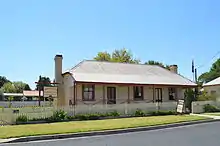
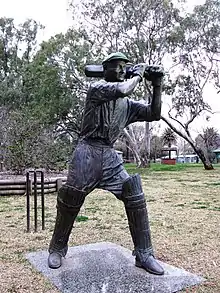
Timeline
- 1847 – Cootamundra Run, a large stock run, is the first colonist settlement in the area.
- 1861 – The site of Cootamundra is published in the NSW Government Gazette
- 1862 – Gold mining commences at the nearby 'Muttama Reef' mine.
- 1864 – The first church (Anglican) and post office are established
- 1874 — Convent for the Presentation Order of nuns opened by (Catholic) Bishop of Goulburn
- 1875 – The first school in the district opens.
- 1877 – Cootamundra's railway connection opens on 1 November.
- 1878 – Christ Church (Anglican) of England opens[5]
- 1879 – St Columba's (Catholic) church opens[6]
- 1884 – Cootamundra is gazetted as a municipality.
- 1896 – Cootamundra Cycling Club. It is probably the oldest continual club in NSW, although as was the case with most clubs it went into recess during the war years.
- 1908 – Donald Bradman (later Sir Donald) is born in Cootamundra.
- 1911–1968 – Cootamundra Domestic Training Home for Aboriginal Girls forcibly taken from their families.
- 1912–1974 – The former Cootamundra Hospital and Cootamundra Aboriginal Girls' Training Home were built upon a hill north east of Cootamundra. The property consists of a large parcel of land which had room for buildings as well as orchards and livestock such as dairy cows.
- 1942 – On 3 December, the corvette HMAS Cootamundra, named for the town, is launched.
- 1951 – Cootamundra Jazz Band is formed by John Ansell
- 1952 – Name of Cootamundry officially changed to Cootamundra.[7]
- 1955 – The first Cootamundra Annual Classic cycling handicap race, one of the oldest open races in NSW.
- 1956 – Cootamundra's rugby league football club's Bill Marsh is first selected to play for the Australian national team.
- 1960 – Cootamundra Blues Australian rules football club is established.[8]
- 1982 – In November 1982, the aviation company Masling Industries is formed. This was restructured in June 1993 after the death of its owner.
- 1986 – Popular Australian singer/songwriter/bush poet John R Williamson released his song 'Cootamundra Wattle'.
- 1998 – Phase 1 of Cricket Captains' Walk declared open; all busts the work of Harden–Murrumburrah sculptor Carl Valerius
- 2000 – The first annual beach volleyball competition. Truckloads of sand are deposited in the main street for "Coota Beach" (punning reference to Kuta Beach in Bali, Indonesia).
- 2015 – Australian youth radio station Triple J featured the 'Cootamundra bonus weather rap'.
- Australian rugby league Kangaroos player Les Boyd grew up representing the Group 9 Cootamundra Bulldogs local team.
Churches
The first churches in Cotamundra were:
- Primitive Methodist
Rev. Smith was minister from around 1874, succeeded by J. Spalding, who was minister in 1877, and services were held on alternate Sunday afternoons.
- Wesleyan Methodist
The church, seating 100 persons, was opened on 17 December 1876. Rev. G. Thompson was minister in 1878[9] and services were held regularly.[10] In 1880 Rev. R. East was the only minister resident in the town.[11]
- Anglican
Christ Church opened on 12 July 1878; the vicar W. Cocks shared with Murrumburrah. In January 1880 Rev. S. B. Holt left Gundagai to take up the position.
- Roman Catholic
Eighty confirmations were performed in 1875 in conjunction with a jubilee attended by Bishop Lanigan of Goulburn and Fathers Bermingham (Burrowa), Dunne and O'Dwyer (Gundagai), and Hanley (Goulburn).[12] Mass was held fortnightly in the schoolroom by visiting priests from Gundagai.[13] St Columba's church was consecrated on 30 November 1879.[14] The first resident pastor was Rev. Richard Butler in 1881.
Heritage listings
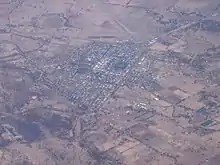
Cootamundra has a number of heritage-listed sites, including:
- Cootamundra-Griffith railway: Cootamundra West railway station[15]
- Main Southern railway: Cootamundra railway station[16]
- 39 Rinkin Street: Cootamundra Domestic Training Home for Aboriginal Girls[17]
- 219 Sutton Street: Cootamundra World War II Fuel Depot[18]
Military history
During World War II, Cootamundra was the location of RAAF No.3 Inland Aircraft Fuel Depot (IAFD), completed in 1942 and closed on 14 June 1944. It was located in an area of land near the intersection of Olympic Highway and Thompson Street. Usually consisting of 4 tanks, 31 fuel depots were built across Australia for the storage and supply of aircraft fuel for the RAAF and the US Army Air Forces at a total cost of £900,000 ($1,800,000).[19]
Climate
Cootamundra yields a typical climate of the lower South West Slopes region; hot, dry summers with severe thunderstorms, and cool winters with many rain days. Occasionally, snow may fall during the winter months, with the most recent settled snowfall having occurred in August 2019 (alongside Tumut). Under the Köppen climate classification scheme, the town has a humid subtropical climate (Cfa), receiving enough precipitation to avoid the semi-arid (BSk) climate classification.
| Climate data for Cootamundra Airport (1995–2020); 335 m AMSL; 34° 37′ 47.64″ S | |||||||||||||
|---|---|---|---|---|---|---|---|---|---|---|---|---|---|
| Month | Jan | Feb | Mar | Apr | May | Jun | Jul | Aug | Sep | Oct | Nov | Dec | Year |
| Record high °C (°F) | 45.0 (113.0) |
43.0 (109.4) |
39.7 (103.5) |
33.5 (92.3) |
27.0 (80.6) |
22.0 (71.6) |
20.5 (68.9) |
24.8 (76.6) |
30.2 (86.4) |
34.9 (94.8) |
41.0 (105.8) |
42.2 (108.0) |
45.0 (113.0) |
| Average high °C (°F) | 32.3 (90.1) |
30.6 (87.1) |
27.4 (81.3) |
22.9 (73.2) |
17.6 (63.7) |
14.0 (57.2) |
13.0 (55.4) |
14.6 (58.3) |
18.3 (64.9) |
22.6 (72.7) |
26.4 (79.5) |
29.5 (85.1) |
22.4 (72.4) |
| Average low °C (°F) | 16.2 (61.2) |
15.6 (60.1) |
12.3 (54.1) |
7.5 (45.5) |
3.5 (38.3) |
2.0 (35.6) |
1.1 (34.0) |
1.4 (34.5) |
3.4 (38.1) |
6.1 (43.0) |
10.4 (50.7) |
13.1 (55.6) |
7.7 (45.9) |
| Record low °C (°F) | 2.0 (35.6) |
2.9 (37.2) |
0.9 (33.6) |
−4.0 (24.8) |
−6.5 (20.3) |
−7.3 (18.9) |
−7.8 (18.0) |
−7.0 (19.4) |
−6.0 (21.2) |
−3.5 (25.7) |
−1.4 (29.5) |
2.2 (36.0) |
−7.8 (18.0) |
| Average precipitation mm (inches) | 43.6 (1.72) |
54.7 (2.15) |
51.5 (2.03) |
31.7 (1.25) |
36.3 (1.43) |
59.5 (2.34) |
56.9 (2.24) |
52.7 (2.07) |
50.8 (2.00) |
43.7 (1.72) |
58.9 (2.32) |
53.4 (2.10) |
593.7 (23.37) |
| Average precipitation days (≥ 0.2 mm) | 6.5 | 5.5 | 6.5 | 4.8 | 7.4 | 10.7 | 12.6 | 11.2 | 8.7 | 7.8 | 7.7 | 6.5 | 95.9 |
| Source: Australian Bureau of Meteorology; Cootamundra Airport | |||||||||||||
Population
According to the 2016 census of Population, there were 6,782 people in Cootamundra.
- Aboriginal and Torres Strait Islander people made up 5.6% of the population.
- 85.6% of people were born in Australia. The next most common country of birth was England at 2.1%.
- 91.6% of people spoke only English at home.
- The most common responses for religion were Catholic 30.8%, Anglican 28.4% and No Religion 16.4%.[1]
In popular culture
- In The Two Ronnies' sketch "The Australians", Cootamundra is the location of their travel agency.[20]
- Leonard Hubbard recorded the song "Cootamundra" in 1924.[21]
- The Cootamundra Jazz Band (1951–1960) was one of Australia's foremost Dixieland groups
- John Williamson recorded the song "Cootamundra Wattle" in 1986.[22]
Notable residents
- Isaac Smith (30 December 1988) - premiership winning player for Hawthorn Football Club in the AFL.
- Hayley Manwaring (born 1991) - singer/guitarist in alternative rock band Moaning Lisa and National Live Music Award winner.
- Thomas Bradley (born 1990) - professional contemporary dancer who has danced for the internationally renowned Sydney Dance Company and Australian Dance Theatre.
- Paul Beath (born 1968)- represented the Canberra Raiders and Manly Seagles in the NRL
- Philip Lowe (born 1961/1962) - Governor of the Reserve Bank of Australia, moved to Cootamundra aged 5.
- Sir Donald Bradman AC (27 August 1908 – 25 February 2001), an Australian international cricketer, born in Cootamundra[23]
- Bob Holder, rodeo champion[24]
- Billy Murdoch (18 October 1854 – 18 February 1911), an Australian cricketer who captained the Australian national side in sixteen Test matches between 1880 and 1890
- Hubert Leslie Primrose (1880–1942), solicitor and politician[25]
- Ethelbert Ambrook Southee (1890–1968), college principal[26]
Transport
Cootamundra railway station is located on the Main Southern railway line, with passengers served in each direction by twice daily NSW TrainLink XPT railway services between Sydney and Melbourne, and the weekly Xplorer railway services to Griffith. Interstate freight trains also pass through the town.
Regional Rail Logistics previously operated a containerised freight service from Junee to Sydney stopping in the town,[27]
| Preceding station | Following station | |||
|---|---|---|---|---|
| Junee | NSW TrainLink Southern Line Griffith Xplorer Melbourne XPT |
Harden toward Sydney | ||
TrainLink coaches
Cootamundra acts as a hub for coach services, run by Transport for NSW, to other regional centres with departures and arrivals timed to connect with certain New South Wales XPT train arrivals. The exception is Services 704/703 (coloured row), provided for those who have business in Canberra civic, the major hospitals, or to connect with the Canberra–Sydney rail service (three trains per day both directions).
Seats are allocated and must be booked ahead.[28] must be consulted for conditions of travel and coach stop locations. On-line booking and more information[29]
| Destination/s | Other stops | Service # | Frequency | Return # | Frequency | Notes |
|---|---|---|---|---|---|---|
| Condobolin | see timetable | 717 | Daily | 718 | Daily | |
| Tumbarumba | see timetable | 723 | Tue/Thu/Sun | 724 | Tue/Thu/Sun | |
| Griffith, Hay, Mildura | see timetable | 725 | Daily | 726 | Daily | ~20 min. refreshment stop at Hay |
| Yass Junction, Canberra, Queanbeyan | see timetable | 782 | Daily | 781 | Daily | ~15 min. stop at Yass Junction. Wheelchair access |
| Parkes, Dubbo | see timetable | 791 | Mon/Wed/Sat | 792 | Sun/Tue/Thu | Wheelchair access |
| Orange, Bathurst | see timetable | 793 | Tue/Thu/Fri/Sun | 794 | Mon/Wed/Fri/Sat | |
| Major stop on route: Wagga Wagga–Cootamundra–Canberra–Queanbeyan | see timetable[30] | 704[31] | Tue/Thu/Sat (morning) | 703[32] | Tue/Thu/Sat (evening) | currently (2019) a trial service, trial timetable, Wheelchair access |
Cricket Captains' Walk
In 1998 a collection of 14 captains of the Australia International Test XI cricket team was unveiled in Jubilee Park, adjacent the Caravan Park. Specially commissioned, they were all the work of Harden-Murrumburrah sculptor Carl Valerius. In 2008 a further 30 busts were installed on either side of a looping path, making a full set of Australian Test cricket captains, with three more added in 2020 to bring the list up to date. These are by various artists from the Tom Bass sculpture studio. The all-weather path, which starts and ends at Wallendoon Street is family, jogger, and wheelchair friendly, and approximately 250 metres long.
A life-sized bronze statue of Bradman in action, also by Valerius, is nearby, as is a newly-installed barbecue and playground. Jubilee Park, the site of these attractions, is on land reclaimed from the original stock dam, memorialized by a plaque on the Morgan Arch on Wallendoon Street.
The Giant
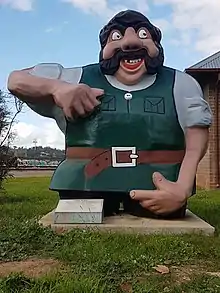
The large effigy of a fairytale giant was created by an unknown artist around 1975 in fibreglass as a mascot for "The Giant Supermarket" on the corner of Cooper and Wallendoon streets.
- This location was in 1882 the site of Kibby's "Trade Palace" department store;[33] and taken over by Solomon Cohen (c. 1848–1922) in 1886.[34] In 1943 it became "Cohen's Corner",[35] a name which endures to this day. "Hammond and Hanlon" were tenants in 1962 and "The Giant" in 1975, subsequently "U-Mark-it", "Half-case Warehouse", "Payless", and "Food World". It next became Mark Ward's hardware store, then "GV Bargains".
When the statue was taken down it was purchased by Allan and Phuong Jenkins, who ran a florist shop nearby. In 1985 Allan participated in a Round-Australia marathon run by Rotary International and the Australian Cancer Society as a fundraiser, and his support vehicle was surmounted by "The Giant". In 2014 the Jenkins couple donated the statue to the Cootamundra Heritage Centre. Local artist Jim Newman did its original paintwork back in 1975, and his brother Robert Newman was responsible for its restoration in 2015.[36] The statue is located alongside the Heritage Centre on Hovell Street, near the railway station.
Sister cities
References
- Australian Bureau of Statistics (27 June 2017). "Cootamundra (State Suburb)". 2016 Census QuickStats. Retrieved 4 February 2018.

- "Mayor – Cr Abb McAlister | Cootamundra Gundagai Regional Council".
- "Cootamundra". VisitNSW.com. Retrieved 17 June 2013.
- McNicol, Sally; Hosking, Dianne (1994). "Wiradjuri". Macquarie Aboriginal Words. Sydney: Macquarie Library. p. 97.
- "Cootamundra Church of England". The Burrangong Argus. New South Wales, Australia. 17 July 1878. p. 2. Retrieved 10 August 2020 – via National Library of Australia.
- "Opening of St Columba Catholic Church". Cootamundra Herald. III (45). New South Wales, Australia. 6 December 1879. p. 2. Retrieved 10 August 2020 – via National Library of Australia.
- SMH 2 February 2004
- "History – Cootamundra Blues". SportsTG.
- "Advertising". Cootamundra Herald. I (49). New South Wales, Australia. 1 January 1878. p. 9. Retrieved 11 August 2020 – via National Library of Australia.
- "Description of Cootamundra". Cootamundra Herald. III (1). New South Wales, Australia. 18 January 1879. p. 2. Retrieved 11 August 2020 – via National Library of Australia.
- "The Australian Handbook". Cootamundra Herald. IV (17). New South Wales, Australia. 1 May 1880. p. 7. Retrieved 11 August 2020 – via National Library of Australia.
- "Cungegong, Cootamundra". Wagga Wagga Advertiser. VIII (39). New South Wales, Australia. 18 September 1875. p. 3. Retrieved 10 August 2020 – via National Library of Australia.
- "Cootamundra". Freeman's Journal. XXX (1850). New South Wales, Australia. 16 August 1879. p. 10. Retrieved 10 August 2020 – via National Library of Australia.
- "Advertising". Gundagai Times and Tumut, Adelong and Murrumbidgee District Advertiser. XXI (1504). New South Wales, Australia. 21 November 1879. p. 3. Retrieved 10 August 2020 – via National Library of Australia.
- "Cootamundra West Railway Station group". New South Wales State Heritage Register. Office of Environment and Heritage. H01119. Retrieved 18 May 2018.
- "Cootamundra Railway Station and yard group". New South Wales State Heritage Register. Office of Environment and Heritage. H01118. Retrieved 18 May 2018.
- "Cootamundra Aboriginal Girls' Training Home". New South Wales State Heritage Register. Office of Environment and Heritage. H01873. Retrieved 18 May 2018.
- "Cootamundra World War II Fuel Depot Site (former No.3 AIFD)". New South Wales State Heritage Register. Office of Environment and Heritage. H01943. Retrieved 18 February 2020.
- "Logistics units", Royal Australian Air Force; Historical Section, Australia: AGPS Press, 1995, ISBN 978-0-644-42798-2
- The Two Ronnies (2014). The Two Ronnies The Australians (Web Video). YouTube. Retrieved 11 July 2020.
- National Film and Sound Archive: Does your town have its own song?
- "Cootamundra Wattle". John Williamson. Retrieved 21 November 2018.
- "Donald George Bradman". Bradman Museum. Archived from the original on 1 September 2007. Retrieved 23 August 2008.
- "Meet Bob Holder, the rodeo rider still going strong at 88 years old". Australian Broadcasting Corporation. 19 August 2019. Retrieved 22 August 2019.(transcript of TV interview with Holder by Dominique Schwartz) for The 7.30 Report.
- "Primrose, Hubert Leslie". Australian dictionary of biography. Retrieved 30 March 2015.
- "Southee, Ethelbert Ambrook (1890–1968)". Australian Dictionary of Biography. Retrieved 30 March 2015.
- "New rail service a boost for Riverina". The Daily Advertiser (Wagga Wagga). dailyadvertiser.com.au. 10 December 2008. Retrieved 8 January 2009.
- "Southern timetable". NSW Trainlink. 7 September 2019.
- Regional travel information Transport for NSW
- New day trip coach services Transport for NSW
- Wagga Wagga to Queanbeyan Bus Interchange Transport for NSW
- Queanbeyan Bus Interchange to Wagga Wagga Transport for NSW
- "Another New Building". The Cootamundra Herald. VI (49). New South Wales, Australia. 14 June 1882. p. 2. Retrieved 30 June 2020 – via National Library of Australia.
- "Trade Palace". Cootamundra Herald. X (10). New South Wales, Australia. 3 February 1886. p. 5. Retrieved 30 June 2020 – via National Library of Australia.
- "Local & General". Cootamundra Herald. New South Wales, Australia. 9 November 1943. p. 2. Retrieved 30 June 2020 – via National Library of Australia.
- From plaque accompanying the statue
- Sister Partnerships by US State
External links
| Wikimedia Commons has media related to Cootamundra. |

